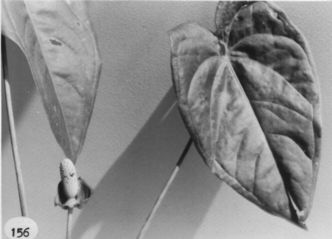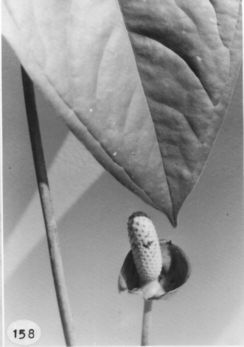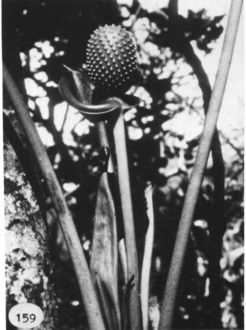






Anthurium globosum Croat, sp. nov.
TYPE: Panama. Chiriquí: Palo Alto, 4.5 mi. NE of Boquete, in forest along trail towards Cerro La Trompeta, Hammel 7445 (MO 2904975, holotype).
Epiphytic or terrestrial; stems to 25 cm long, 1-2 cm diam.; leaf scars obscured by persisting cataphylls; roots long, thin; cataphylls coriaceous, 12-20 cm long; drying reddish brown (B & K Yellow-red 4/7.5), persisting intact.
LEAVES erect to erect-spreading; petioles (17-)25-62 cm long, ca. 4 mm diam., terete; geniculum 2-2.5 cm long; blades ovate to ovate triangular, moderately thick, long-acuminate at apex, deeply lobed at base, 21-36 cm long, 11.5-20 cm wide, broadest at point of petiole attachment or just above; anterior lobe 13.5-27 cm long, the margins rounded; posterior lobes 6-11.5 cm long, from apex of sinus to outermost point; the sinus hippocrepiform, rounded at apex; upper surface semiglossy with conspicuous raphide cells, lower surface drying matte; midrib raised above and below; basal veins 4-5 pairs, the first, sometimes second free to the base, the second to fifth coalesced 0.6-4.5 cm, raised above, prominently raised below; posterior rib naked, the inner margin weakly turned up; primary lateral veins 3-5 per side, departing the midrib at a 45-60° angle, sunken above, raised below, drying scarcely more conspicuous than lesser veins on upper surface, more prominent below, lesser veins visible on drying; collective arising from the first or second basal vein or sometimes from the third, 5-8 mm from margin, sunken above, raised below.
INFLORESCENCE more or less erect, much shorter than leaves, peduncle 4÷30 cm long, 4÷6 mm diam., one-fifth to two-thirds as long as petioles; spathe subcoriaceous, green, ovate-elliptic, 3-5 cm long, 1.5-4.5 cm wide, broadest near the middle, rounded at apex, rounded to more or less obtuse at base, held erect at anthesis; stipe to 4 mm long; spadix white, becoming red- violet, short, cylindroid (scarcely tapered) to globose, 2-5.3 cm long, 7.5-20 mm diam. midway, flowers 4-lobed, ca. 1.5 mm long, 2.5 mm wide, the sides straight to weakly sigmoid; ca. 8 flowers visible in the principal spiral, ca. 12 flowers visible in the alternate spiral; tepals glossy, the lateral tepals ca. 0.6 mm wide, the inner margin rounded, the outer margin 3-4-sided; pistils raised, emergent; stamens held over and obscuring pistil; anthers white, 0.8 mm wide (dry).
INFRUCTESCENCE erect-spreading; spathe reflexed; spadix 4-6 cm long, ca. 3.5 cm diam.; berries orange to red-orange, oblong-elliptic, 1.3-1.5 cm long, 5-5.5 mm diam., mesocarp white, gelatinous, with raphide cells; seeds 1-2, pale green to yellow, 4.3-4.5 mm long, 2.3-2.8 mm wide, appendaged at apex, surounded by a clear mucilaginous sac. Figs. 156, 158, and 159.
Anthurium globosum is known only from western Panama in Bocas del Toro and Chiriquí Provinces at 1,700 to 2,300 m in lower montane rain forest and has only been found near Boquete.
The species is in section Calomystrium and is recognized by its ovate to ovate-triangular blades, its short pedunculate inflorescence, its cylindroid, scarcely tapered, often globose spadix, and by its erect, broadly ovate spathe.
Although Anthurium globosum is quite distinctive and not easily confused with any other species, the spadix may vary from white to red-violet (apparently becoming red-violet as it matures). There also seems to be a variation in the coloration of the leaves on drying with a few specimens (e.g., Mori & Bolten 7480 and Kirkbride & Duke 936) drying rather gray while the others dry brown to reddish brown.
 |
 |
 |
Map of Mesoamerican specimens with coordinates
Panama Chiriquí: 1099 m, 8.40N 82.13W, 18 Sept. 1987, Thomas B. Croat
67737 (MO).
Panama Chiriquí: 1750-1900 m, 8.41N 82.10W, 22 Sept. 1987, Thomas B.
Croat 67966 (MO).
Panama Chiriquí: 1750-1900 m, 8.41N 82.10W, 22 Sept. 1987, Thomas B.
Croat 67977 (CM,MEXU,MO,SCZ).
Panama Chiriquí: 1900 m,, 27 Apr. 1993, Hodel et al. 1246 (MO).
Panama Chiriquí: 1600 m, 8.48N 82.24W, 06 Feb 1986, Barry Hammel, G.
McPherson, M. Grayum, A. Smith & al. 14397 (MO).
Panama Chiriquí: Cerro Horqueta, 1800 m,, 20 Oct 1980, Maas & Dressler
4970 (U).